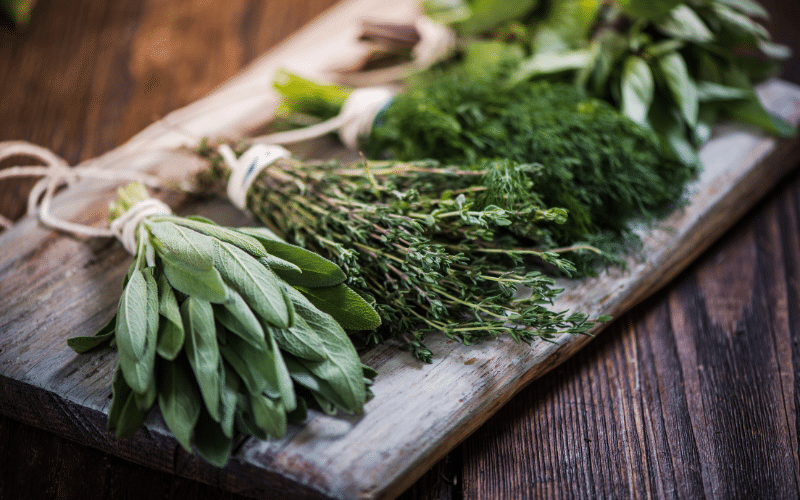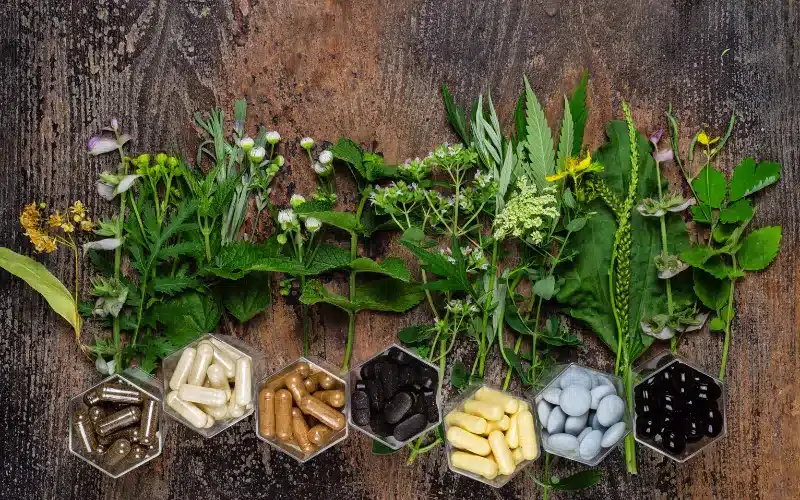Written by Dr. Diane Mueller
Lyme disease can feel like an invisible weight, like your body is fighting a battle it can’t win—aches, fatigue, and brain fog. But what if nature held some answers? Herbs, used for centuries in healing practices, are gaining attention as potential allies in managing Lyme disease symptoms. You might be wondering, can something as simple as herbs for Lyme disease really make a difference? The truth is, certain herbs are believed to support your immune system, reduce inflammation, and even target the bacteria behind Lyme. While they’re not a magic aid, they could be a valuable piece of the puzzle in your recovery journey.
Key Takeaways
Herbs like Cryptolepis, Japanese Knotweed, and Cat’s Claw show promise in supporting Lyme disease recovery by targeting bacteria, breaking biofilms, and reducing inflammation.
Functional medicine combines herbal treatments, lifestyle changes, and supplements to address Lyme disease holistically, offering a more tailored and effective approach to healing.
A well-rounded herbal protocol should include immune-boosting, anti-inflammatory, and detoxifying herbs, along with biofilm busters for maximum effectiveness.
Supplements such as probiotics, Omega-3 fatty acids, and CoQ10 complement herbal treatments by supporting gut health, reducing inflammation, and enhancing energy.
Working with a Lyme-literate practitioner ensures a safe and personalized treatment plan, avoiding dosage errors and potential interactions with other therapies.
Patience and consistency are key; Lyme recovery often requires time, tracking progress, and making adjustments along the way.
Table of Contents
Understanding Herbal Therapy for Lyme Disease
Herbal therapy provides hope for Lyme disease by easing symptoms and supporting recovery. Unlike antibiotics, which may cause Lyme bacteria to become dormant, herbs work in multiple ways to promote healing.
What Makes Herbs for Lyme Disease Essential?
Lyme disease can hide and resurface after treatment. While antibiotics like doxycycline target active bacteria, Lyme can switch to a dormant state, making it harder to eliminate. Lyme disease natural treatment using herbs are particularly effective in addressing this challenge.
Herbs don’t just target the active bacteria; they also support your body naturally, such as battling inflammation and bolstering your immune system. For example, herbs like Japanese knotweed and Chinese skullcap have anti-inflammatory properties that may help reduce those nagging aches and sluggish fatigue*. Meanwhile, cat’s claw helps unmask bacterial hiding spots by breaking down biofilms, the slimy shields that protect Lyme bacteria.
While antibiotics are the standard treatment, herbal remedies aim to address the root causes of lingering symptoms for a more well-rounded way to tackle the disease. Used wisely, they can become a cornerstone of your Lyme recovery toolkit.
Have Lyme Disease or suspect you do?
Functional Medicine: Forefront in Tackling Lyme Disease
Functional medicine takes a versatile approach, using tools from different traditions. For Lyme disease, being “Lyme-literate“ is crucial, involving layered treatments with herbs, supplements, and lifestyle adjustments tailored to individual needs.
A functional medicine expert in Lyme—such as My Lyme Doc—doesn’t just focus on killing bacteria; they look at your full-body health. Chronic Lyme can be a master of disguise, imitating issues like chronic fatigue syndrome or fibromyalgia. Functional medicine acknowledges these overlaps and works to repair your gut, boost your immune resilience, and address underlying stress—all things Lyme loves to exploit. It’s like having a healthcare detective who sees the full picture rather than just chasing symptoms.
Herbal therapy fits perfectly into this model because it’s adaptable. For example, Black walnut might be introduced to tackle parasites, while cryptolepis targets the stubborn Borrelia bacteria. By combining these with refresh strategies (such as sauna sessions and plenty of water), functional medicine aims to restore balance.

Key Herbs for Lyme Disease Treatment
When it comes to battling Lyme disease, certain herbs stand out for their ability to tackle pesky bacteria, relieve symptoms, and support your immune system.
Cryptolepis: The Game-Changer
Cryptolepis sanguinolenta is a top herb for Lyme disease treatment, known for its ability to kill dormant, “persister” Borrelia bacteria, which cause chronic and recurring infections**. Unlike antibiotics like doxycycline, Cryptolepis for Lyme targets the infection even when it’s hidden. What’s more, Cryptolepis doesn’t stop at bacterial eradication. It also contains anti-inflammatory and immune-supporting benefits that can help reduce long-term complications.
Other Potent Herbs with Antimicrobial Effects
Cryptolepis doesn’t work alone. Other herbs bring their own strengths to the table, creating a well-rounded natural protocol:
Japanese Knotweed (Polygonum cuspidatum): Famous for its ability to reduce inflammation, this herb also stimulates your immune system and crosses the blood-brain barrier, making it especially valuable for neurological Lyme symptoms like brain fog.
Cat’s Claw (Uncaria tomentosa): Strengthens your immune system, breaks down bacterial biofilms, and eases oxidative stress.
Chinese Skullcap (Scutellaria baicalensis): With potent antimicrobial and anti-inflammatory properties, this herb works to fight infection and calm overactive immune responses.
Sweet Wormwood (Artemisia annua): Known for its success in malaria treatments, this herb shows promise in its broad-spectrum antimicrobial activity, giving Lyme bacteria one less place to thrive.
Have Lyme Disease or suspect you do?
Building Your Herbal Protocol
To create your herbal protocol for Lyme disease, you’ have to find the right pieces that fit your unique picture. Herbs work differently for everyone, so think of this as your customizable blueprint. Here’s how you can get started:
1. Start with Strong Foundations
Choose herbs that cover the Lyme basics. For instance, Cryptolepis sanguinolenta is a powerhouse because of its ability to tackle dormant Borrelia bacteria—a sneaky form often untouched by antibiotics. Pair it with Japanese knotweed, which reduces inflammation and supports nerve health. These herbs give you a strong, multi-faceted base to build from.
2. Add Biofilm Busters
Lyme bacteria create biofilms for survival. Herbs like Cat’s claw can cut through these barriers. Including such herbs in your protocol ensures no bacteria evade detection.
3. Incorporate Immune Boosters
Your immune system is your best ally, but Lyme often drags it through the mud. Strengthen it with herbs like Chinese skullcap. This herb not only fights bacteria but also calms inflammation, letting your body recover without overreacting.
4. Target Inflammation at Its Core
Inflammation is the root of many Lyme symptoms. Japanese knotweed and sweet wormwood are herbal MVPs in this area. They help reduce swelling, ease joint pain, and even improve brain fog.
5. Balance the Blend
A mix of herbs can often accomplish what a single herb cannot. Combinations like those in herbal formulas pair anti-inflammatory, antimicrobial, and immune-supporting properties. These blends are like your personal multi-tasking army.
6. Add Refresh Support
Lyme bacteria release toxins as they die off, which can leave you feeling worse before you feel better (yes, the dreaded Herxheimer reaction). Stay ahead of this with refresh-friendly herbs like garlic or functional tools like saunas and extra hydration. Herbs aid your kidneys, liver, and lymphatic system to kick toxins out fast.
7. Monitor Progress & Tweak
Herbal protocols aren’t one-size-fits-all, so keep track of what’s working. Maybe sweet wormwood helps your fatigue but inflames your stomach. Talk to your practitioner if adjustments are needed. Flexibility is key—it’s like learning a new recipe, tweaking the ingredients until it’s just right for you.
8. Work With a Practitioner
Working with a Lyme-literate functional medicine practitioner can save you from expensive mistakes. Practitioners help you avoid interactions between herbs, antibiotics, or any other treatments you’re on.
Pro Tip: Low & Slow Does It
When introducing herbs, start with small doses and gradually increase. Lyme refresh can feel like you’re cleaning out a messy closet—if you do it all at once, you’ll be overwhelmed. Easing into a protocol helps you sidestep unnecessary discomfort.

Supplements That Support Herbal Lyme Treatment
While herbs like Cryptolepis and Japanese knotweed do a lot of the heavy lifting, certain supplements are great to fill the gaps. They’re allies that help your body recover and thrive. Here’s a closer look:
Probiotics to Restore Gut Health
Antibiotics, while necessary for treating Lyme, can leave your gut feeling like it’s under siege. That’s where probiotics step up. Think live cultures—like those found in yogurt or supplements—that replenish good bacteria and balance your microbiome. A healthy gut doesn’t just aid digestion; it boosts your immune system, improving your body’s defense against Lyme.
Omega-3 Fatty Acids for Inflammation
Chronic inflammation feels like a wildfire raging in your body, and Omega-3s, found in fish oil or flaxseed, act like buckets of water. They help calm joint pain, brain fog, and other irritating symptoms. Plus, they’re good for your heart—a win-win!
Magnesium for Muscle Function and Sleep
Lyme drains your energy—cue muscle cramps and sleepless nights. Magnesium can help you by relaxing your tight muscles, support nerve function, and even helps you catch those elusive zzz’s. You can grab it in supplement form or through foods like spinach, avocado, and almonds.
Vitamin D to Recharge Your Immune System
With Lyme attacking your immunity, you’ll want to give it a boost. Vitamin D, the kind you soak up from sunlight or find in supplements, strengthens your immune response and staves off fatigue.
CoQ10 for Energy Support
Lyme fatigue feels like having a battery that never quite charges past 20%. Enter Coenzyme Q10, a molecule your cells need to produce energy. By supporting your mitochondria, CoQ10 helps reclaim your energy levels and gets you moving again.
N-acetylcysteine (NAC) for Detoxification
Your body collects toxins like a sponge while fighting Lyme. NAC works like a refresh smoothie, helping your liver process and flush out these unwelcome guests. It’s also a precursor to glutathione—a powerful antioxidant that boosts cellular repair.
B-Complex Vitamins for Cognitive Clarity
B vitamins, particularly B6 and B12, help fire up neurotransmitters in your brain to combat brain fog. They’re helpful for energy, focus, and even improving mood.
Zinc to Combat Bacteria
Zinc plays a starring role in immune health. It hampers Lyme-causing bacteria like a well-timed defense mechanism while promoting wound healing. You can find it in pumpkin seeds, shellfish, or supplements.
Have Lyme Disease or suspect you do?
Pro Tip: Layer, Don’t Stack
It’s tempting to grab a cartload of supplements, but balance is key. Think of it like building a sandwich—you need the right ingredients in the right order for it to work. Work with a Lyme-literate practitioner to design a stack that complements your herbal treatment without overwhelming your system.
Quick Herbal Reference Table
Herbal Ally | Supplement Sidekick | Purpose |
|---|---|---|
Cryptolepis | Zinc | Fights bacteria |
Japanese Knotweed | Omega-3 Fatty Acids | Reduces inflammation |
Cat’s Claw | Probiotics | Supports gut health and immunity |
Sweet Wormwood | CoQ10 | Boosts energy |
Chinese Skullcap | Vitamin D | Strengthens immune response |
Each supplement on this list isn’t just a supplement—it’s a partner in helping your body feel more like you again. Trust your instincts, gather your allies, and piece your puzzle together one thoughtful step at a time.

Mistakes to Avoid in Herbal Lyme Treatment
1. Skipping Professional Guidance
Rushing into natural remedies without expert advice can backfire. Lyme disease is complicated with symptoms that mimic other conditions. Without proper guidance, you might end up treating the wrong issue, or worse, cause additional harm. Start by consulting a Lyme expert who knows these therapies inside out.
2. Ignoring Dosages and Timing
You wouldn’t guzzle down a whole bottle of supplements thinking more is better, right? But misjudging doses with natural treatments happens more often than you’d think. Herbs like Cryptolepis or Japanese knotweed are potent allies in Lyme treatment but need carefully measured amounts. Follow instructions or work with a pro to get the timing and dose just right to keep your body happy and on track.
3. Not Balancing Detoxification
Your body needs to expel toxins as it fights Lyme, that’s why you can’t jump into a full-scale refresh without preparation. Over-detoxing can strain your liver and kidneys. Support the process gently with supplements like NAC (N-Acetylcysteine) and stay hydrated to avoid refresh crashes.
4. Neglecting Diet and Lifestyle Changes
Herbal therapy is one piece of the puzzle, not the whole picture. Without eating an anti-inflammatory diet, getting enough sleep, or managing stress, you’re like a cyclist trying to race with a flat tire. Pair your treatment with nutrient-rich meals, regular movement, and tailored self-care practices to optimize results.
5. Using Poor-Quality Herbs
Buying cheap, poorly sourced herbs is like fueling your car with dirty gas—it may run, but not well. High-quality, lab-tested herbs are essential for safe and effective Lyme treatment. Look for trusted brands or ensure your practitioner sources reputable products. A little research upfront can save you expensive headaches down the road.
6. Expecting Instant Results
Patience isn’t just a virtue—it’s essential. Natural treatments take time to kick in, so don’t ditch your protocol after just a few weeks. Document your progress, celebrate small wins, and trust the process.
7. Underestimating the Healing Journey
Lyme disease doesn’t just affect your body—it challenges your emotions, energy, and patience. Forgetting the mental aspect of healing can leave you feeling overwhelmed. Surround yourself with a supportive community, join Lyme forums, and consider therapies like mindfulness meditation to help balance your emotional well-being during treatment.
Have Lyme Disease or suspect you do?
Conclusion
Battling Lyme disease is tiring and the process can take a lot of time, mental space, energy, and effort, but incorporating herbs into your treatment plan offers a powerful, natural way to support your recovery. By focusing on immune health, inflammation reduction, and addressing the root causes of symptoms, herbal therapy provides a functional medicine approach that complements traditional methods.
Working with a Lyme disease practitioner ensures your protocol is made for your unique needs, helping you avoid mistakes and optimize your healing journey. With patience, consistency, and the right combination of herbs and supplements, you can take meaningful steps toward reclaiming your health and well-being.
For more information on the topic of Lyme Disease Treatments, see our other blog below:
Frequently Asked Questions
Herbal remedies may support Lyme recovery by reducing inflammation, boosting the immune system, and targeting bacteria. Herbs like Japanese knotweed and cat’s claw help address symptoms and support overall healing.
Herbal remedies can complement traditional treatments but may not replace them. A combination of antibiotics, functional medicine, and lifestyle changes is often recommended for optimal recovery.
Biofilm busters, like cat’s claw, break down protective barriers (biofilms) that Lyme bacteria form to shield themselves. Using these herbs allows treatments to reach and eliminate bacteria more effectively.
Supplements like probiotics, Omega-3 fatty acids, vitamin D, magnesium, and CoQ10 can fill nutritional gaps, boost immunity, reduce inflammation, and improve energy during Lyme recovery. Partner with a practitioner to create a balanced regimen.
Key herbs for Lyme disease include Cryptolepis sanguinolenta (antibacterial), Japanese knotweed (anti-inflammatory), cat’s claw (biofilm buster), Chinese skullcap (immune support), and sweet wormwood (antimicrobial).
Start with foundational herbs like Cryptolepis and Japanese knotweed. Incorporate biofilm busters and immune boosters, monitor progress, and work with an expert to adjust doses and target specific symptoms.
References
*Zhang H, et al. (2021). “Anti-inflammatory and Antioxidant Activities of Japanese Knotweed (Polygonum cuspidatum) Extracts.” Journal of Ethnopharmacology. doi: 10.1016/j.jep.2021.113876.
*Wang X, et al. (2018). “Baicalin, an Active Component of Scutellaria baicalensis, Reduces Inflammation in Patients with Rheumatoid Arthritis and Coronary Artery Disease.” Evidence-Based Complementary and Alternative Medicine. doi: 10.1155/2018/3746060.
*Kim EH, et al. (2014). “Anti-inflammatory Effects of Scutellaria baicalensis Extract in Osteoarthritis.” Journal of Medicinal Food. doi: 10.1089/jmf.2013.2958.
**Feng J, Leone J, Schweig S, Zhang Y. Evaluation of Natural and Botanical Medicines for Activity Against Growing and Non-growing Forms of B. burgdorferi. Front Med (Lausanne). 2020 Feb 21;7:6. doi: 10.3389/fmed.2020.00006. PMID: 32154254; PMCID: PMC7050641. https://www.frontiersin.org/journals/medicine/articles/10.3389/fmed.2020.00006/full
Kim WS, Choi WJ, Lee S, et al. (2014). “Anti-inflammatory, Antioxidant and Antimicrobial Effects of Artemisinin Extracts from Artemisia annua L.” Korean J Physiol Pharmacol. doi: 10.4196/kjpp.2015.19.1.21.
Free Lyme/Mold Webinar: "Why Am I Still Sick?"
Have Lyme Disease or suspect that you do?
We have helped thousands of
people restore their health
and quality of life by diagnosing
and treating their Lyme Disease.
“Dr. Mueller’s approach to medicine is refreshing! There is only so much you can do with western medicine and in my life I was needing a new approach. By addressing the whole body, nutritional diet factors, environmental factors, blood work, and incorporating ideas I had not previously known, I was able to break through with my conditions. I am not only experiencing less pain in my life, but through the process of healing guided by Dr. Diane Mueller, I am now happy to say I have more consciousness surrounding how I eat, what to eat and when things are appropriate. Living by example Dr. Mueller has a vibrancy that makes you want to learn and know more about your body and overall health. I highly recommend her to anyone looking for new answers, a new approach to health, or in need of freedom from pain and limitations.”
-Storie S.
Kihei, HI


